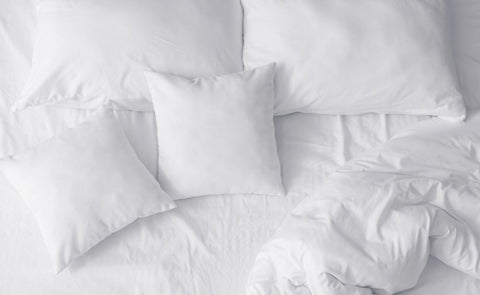Selecting the right pillow is crucial for a comfortable night's sleep. Your choice can have a significant impact on your overall sleep quality and health, particularly concerning neck and back alignments. The perfect pillow varies from person to person as it depends on individual sleep positions, mattress firmness, and personal preferences.
Comfort is paramount when it comes to pillows, but the definition of comfort is subjective. Side sleepers often require a pillow with enough loft to maintain neck and spinal alignment, whereas back sleepers might need a pillow that supports the natural curve of their cervical spine. Stomach sleepers tend to benefit from softer, lower-loft pillows to reduce stress on the neck. Moreover, material options like memory foam, latex, and down have distinct qualities that cater to different needs, from hypoallergenic properties to contoured support.
Beyond personal comfort, a proper pillow can contribute to your health by reducing the potential for waking up with pain or stiffness. It’s worth noting that a pillow that adequately supports your head, neck, and shoulders can help maintain proper alignment of the spine, which is an essential aspect of sleep ergonomics. Invest time in understanding your sleep needs as a well-chosen pillow can be a simple yet effective step to enhance your sleep experience.
Understanding Pillow Materials and Types
When choosing the right pillow, understanding the materials and types available is essential in finding one that meets your specific needs.
Natural Versus Synthetic Fillings
Pillows can be filled with a variety of natural or synthetic materials, each offering distinct benefits. Down and feathers are common natural fillings; down pillows are prized for their softness and insulating properties, while feather pillows offer somewhat firmer support. On the other side, synthetic options such as polyester and down alternative pillows are hypoallergenic and generally easier to care for. Memory foam and latex represent other synthetic options. Memory foam pillows contour to your head and neck, providing excellent support, whereas latex pillows offer a firmer, bouncy feel and are both durable and resistant to dust mites.
-
Natural Fillings:
- Down: Soft, light, and warm
- Feathers: Firmer than down
- Organic materials: Kapok and buckwheat
-
Synthetic Fillings:
- Memory Foam: Contours to shape, reduced pressure points
- Latex: Firm and supportive, long-lasting
- Polyester: Cost-effective, hypoallergenic
- Down Alternate: Hypoallergenic, mimics down
Specialized Pillows for Different Sleepers
Depending on your sleeping position, certain pillows cater specifically to your needs to maintain a proper alignment of your spine. For side sleepers, a cervical pillow or a firm, high-loft pillow helps keep the neck properly aligned. Stomach sleepers may benefit from softer, flatter pillows that prevent unnatural angles in the neck. Memory foam pillows can be a good option for those who need a moldable yet supportive structure. Back sleepers often need a medium-support pillow to maintain the natural curve of their spine, potentially choosing latex pillows for this purpose. Furthermore, if you experience allergies, hypoallergenic pillows made from materials like memory foam, latex, or down alternatives will reduce allergic reactions.
-
Pillows for Side Sleepers:
- High-loft, firm
- Cervical pillows for neck alignment
-
Pillows for Stomach Sleepers:
- Low-loft, soft
-
Pillows for Back Sleepers:
- Medium-loft, medium firmness
-
Hypoallergenic Options:
- Memory foam
- Latex
- Down alternative
Choosing a pillow that is right for you involves considering both the fill material and the type of pillow, ensuring it aligns with your specific sleeping needs for a restful slumber.
Selecting the Correct Loft and Firmness
When selecting a pillow, two critical factors come into play: loft, which relates to the height of the pillow, and firmness, which determines the level of support your head and neck receive. Both aspects are key to maintaining proper spinal alignment throughout the night.
The Importance of Loft
Loft, or the height of your pillow, plays a vital role in keeping your spine straight.
- Low Loft (under 3 inches): Ideal if you sleep on your stomach to avoid arching the spine.
- Medium Loft (3-5 inches): Suitable for back sleepers, as it provides a balance that maintains the natural curvature of the spine.
- High Loft (over 5 inches): Best for side sleepers since it fills the gap between the head and the mattress, keeping the spine horizontal.
It's important to match the pillow loft with your sleep posture to ensure proper neck and spinal alignment.
How Firmness Affects Sleep Quality
Firmness dictates how much support your pillow will provide. A pillow that is too soft may cause your head to sink too deep, while a very firm pillow might elevate your head too high.
- Soft Pillow: Usually compresses more under weight. It conforms well to your head's shape but might not provide enough support, leading to potential neck and back pain.
- Medium Firmness: Offers a balance of comfort and support, which can be effective for a variety of sleeping positions.
- Firm Pillow: Less give under weight, it elevates the head and keeps your neck aligned with the spine. This is often recommended for side sleepers who need more neck and pillow support.
Your personal preference for comfort will also influence your choice, but the primary goal should be to maintain proper alignment of your spine, neck, and head, to enhance your sleep quality.
Aligning Pillow Choice With Sleeping Position
Choosing the right pillow is essential for supporting your neck and spine. Your sleeping position predominantly determines the type of pillow you need for optimal comfort and alignment.
The Best Pillows for Side Sleepers
Side sleepers benefit from a firmer pillow to fill the gap between the head and the mattress, maintaining a straight spine. Look for a pillow with a higher loft that adequately supports your neck and shoulders, ensuring proper alignment. Memory foam or contoured pillows can be particularly suitable as they conform to your head's shape and provide consistent support throughout the night.
Optimal Pillow Choices for Back Sleepers
If you predominantly sleep on your back, you require a pillow that supports the natural curve of your spine. A medium-firm pillow is often a good choice, offering enough support while allowing for some slight sinking of the head. This ensures that your spine stays neutral and reduces the risk of neck pain. Avoid overly thick or stiff pillows, as they can tilt your head unnaturally forward.
Stomach Sleepers' Needs and Solutions
Stomach sleeping often puts pressure on your neck and spine, so go for a thin, soft pillow or even no pillow under your head. Instead, consider placing a pillow under your stomach to help reduce spinal pressure. This can provide a more neutral position for your spine and prevent lower back pain. Stomach sleepers should steer clear of firm, high-loft pillows to avoid forcing the head upward and straining the neck.
When Should you Replace Your Pillow
Recognizing when it's time to replace your pillow is crucial for maintaining proper hygiene and ensuring you get quality sleep.
Stains
If you notice persistent stains from body oils, sweat, or saliva that don’t come out after washing, it’s a sign your pillow needs to be replaced. These stains can harbor bacteria and diminish the effectiveness of your pillow.
Odors
Persistent odors are a clear indication that your pillow is harboring bacteria, mildew, or fungus. If airing out or washing the pillow doesn’t remove the smell, it’s time for a new one.
Physical Wear and Tear
Inspect your pillow for signs of wear, such as rips, tears, or fraying fabric. These defects can affect the pillow's comfort and support and might compromise its ability to maintain its form and function.
Loss of Shape
A pillow that no longer maintains its shape and feels lumpy or flat fails to provide the proper support for your neck and head. Memory foam pillows, for instance, should resume their shape after use. If they don't, consider them due for replacement.



